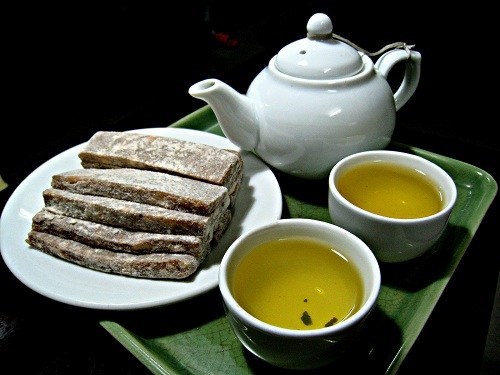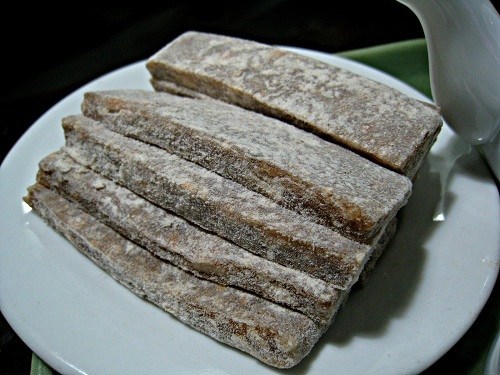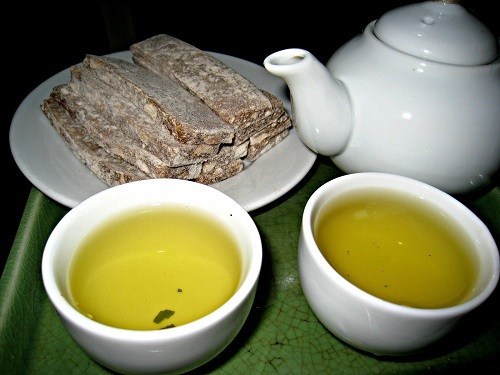In December, my grandmother cooks “nếp cái hoa vàng” - the best sticky rice from which to make desserts, grown specifically in the North - or “nếp nhung” - also a kind of sticky rice, dried under the sun and carefully sifted before fried with sand until it pops open resembling flowers. The kernels are then sifted again so as to remove their skins and any seeds that did not pop.
The popped sticky rice is then ground into a fine powder. The smoother the powder, the more moist the cake will stay. Molasses and malt is mixed in water and boiled on a low flame until it is thickens. It is then mixed with the popped sticky rice, grilled slices of ginger, crushed cardamom and peanuts.
After that the dough is kneaded until it becomes tacky and moist. It is then divided on two trays, each with half - approximately one kilogram - of the dough. Finally it is pressed flat and covered by a thin layer of powder to dry. This also ensures that it cuts smoothly without sticking to the knife.

My grandmother makes “Chè lam” so delicious that all the villagers say that, “Having a bowl of “Chè lam” made by Mrs. Uong with a cup of green tea warms you no matter how cold you feel.” While digging into a bowl of “chè lam” you can feel the softness of the sticky rice, the sweetness of the honey, the spice of the ginger and the richness of the peanuts as the cold of December melt away.
In December, although all rice fields seem dead from the cold and don’t have what we call, “Bờ xôi ruộng mật”. Farmers use this phrase to describe the resemblance between an embankment of the rice field to a delicious sticky rice dish, with the rice field itself sweet as honey in the height of the growing season when it the field is alight with the color of yellow rice plants. At Dong Moi rice field there is still a very good aroma from baked sweet potato, as the children who herd buffalo bake it over a fire made of straw. They are very cute with their rosy cheeks from the cold wind.
In the winter months the sweet from “Chè lam” and the baked sweet potato the children are very happy; their laughter carries over the field. Their laughter brings happiness to farmers who walk by and stop to rest. They laugh alongside and give the children corn and sweet potato so freshly harvested that soil lingers on the vegetables.
All the rice husks are collected to grow the fire stronger, and the party truly begins on the farm. Coming back from the field, my grandmother looked at their smudged faces and asked with a tooth-filled smile - one we lovingly call her twinkling “corn tooth” - “Is the cold is sweet?” They all ran into the kitchen cheering, “Sweet, very sweet grandma!”
Every day she cuts a bar of the “Chè lam” for the children to bring to school as a snack. Sometimes she adds more “Bánh gio”cake for them. Nothing is more comforting than when “Bánh gio” cake is flat and cold, but eaten with “Chè lam” which is sweet and warm from the ginger. The “Chè lam” that grandmother has made is so plentiful that everyone has asked her why she has made so many. She replied that it is so all her children can have them through winter.
“Chè lam” not only keeps out the cold, but is also used to worship ancestors on death anniversaries or national holidays. During Tet holiday - Vietnamese new year - any cake would be missed, but if you do not serve guests “Chè lam” then Tet lacks much of its essence and sense of warmth. Grandmother told me that the mother-in-law normally chooses her daughter-in-law not only based on her family background, but will also check her kitchen and test if she knows how to make “Chè lam” or popped rice.

While “Chè lam” will never be considered a luxurious gift, to cook it the chef must put into the dish all her heart, love, time and attention. For instance, when you make honey if you aren’t careful then the honey will be sour. If the popped rice is cooked over too high a flame the “Chè lam” will have burnt flavor. It is said that just by looking at the way “Chè lam” is made that the mother-in-law can tell if her future daughter-in-law is a patient person and whether or not she knows how to take care of her husband and children.
The person who keeps the fire in the kitchen must be a clever person and appreciate the values of life. It is the same as the sweet taste that you found in “Chè lam” because it is the result of a complex process that requires a lot of time, effort and hard work.
People don’t eat “Chè lam” to be full, but they will eat it slowly to feel the taste of the countryside and the dedicated work that went into the cake. Have a sip of tea to keep your stomach warm, feel the peace and release yourself from busy daily life. Worries won’t be there anymore since the moment the guests come to visit until they leave the house. Even as the wind goes through your jacket the “Chè lam” still stays in your throat with its aroma and taste.
My grandmother told us that we shouldn’t let eating becomes something rude, like the phrase “grasp all, lose all,” but we should pay attention while eating in company and its meaning.
It has been a long time since I have eaten “Chè lam” made by Mrs. Uong, which is the best in Duc Quang village, Viet Yen, Bac Giang province, since she has passed away. I’ve been away from my hometown, leaving behind the “sweet winter” for almost 20 years.
Keeping her tradition alive in December the aunts will usually send “Chè lam” cake to their children in the South, but they are now made from a candy factory. No one has the time anymore to make “Chè lam”. Life turns and turns too busy now.
Perhaps life is too busy that I no longer recognize the cold is integrated into the sweet of “Chè lam” cake to create what we call a “sweet cold”. It is fully of my grandmother’s love that I can’t find in any other “Chè lam” like the one she used to make. In my dream sometimes I see her making it; the first one was always shared with her grandchildren.

Today I hold a piece of “Chè lam”
in my hand and remember the old memories with such emotion. The memory about “Cây nêu” – a lunar new year pole used to
dispel bad spirits, but now many villagers seem to have forgotten it. A memory
of a pagoda with a hundred year old red silk cotton tree that stands guard over
the pagoda, with its buds attracting birds that come to chat with one another.
Also when we cook “ Bánh chưng”-
a sticky square cake - for Tet holiday it is necessary to use a piece of bamboo
to get the fire from the oil lamp of the ancestral worship table to light up
the cooking flame, but this traditional tip is obsolete. I remember when “Bánh chưng” is made it is not only used
to praise the ancestors, but also have given praise to the Water God by leaving
it floating in a pond overnight. And last my memory of the mothers who wash
their hair on the eve of the new year, spiraling their heads around in the
water to create beautiful circles as they do their Spring Dance.
If I don’t record these memories then I am afraid that they will fade,
and my memories will also become cold and poor. As they fade, so do the
memories of going back to my hometown. Perhaps without these thoughts the cold
will actually freeze my body and I will forget the warming sensations of eating
“Chè lam” cake and a cup of green tea.
Acording to V.H
Dan Tri Newspaper
Extracted from articles written especially for the 2014 Golden Spoon
contest called “A journey of searching traditional rustic dishes”